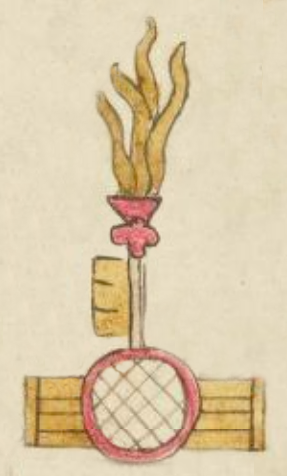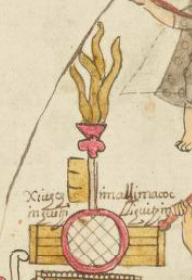xiuhchimalli (Azca16)
This painted black-line drawing for the compound personal name xiuhchimalli (apparently, a turquoise-shield) shows a circular shield (chimalli) with a red border and a mesh pattern in the middle. Perhaps the mesh pattern is a hint about a mosaic that might involve tesserae of turquoise. Behind the shield is something that looks like a horizontal wooden fence made from planks. Coming up from the shield is a post with a flag (panitl) on it, and above the flag is a device that is red at the base and has four golden, wavy feathers going up from there. Perhaps these are references to the name Huitzilihuitl (“Hummingbird Feathers”). According to the gloss, this turquoise shield was given to him.
Stephanie Wood
The translation of xihuitl as turquoise here could be incorrect, given that there is nothing obviously turquoise in the visuals. There are no other Xiuhchimalli or Xiuhchimal glyphs in this database yet (as of May 2025).
Stephanie Wood
xiuhchimalli macoc in huitzilliguitzin
xiuhchimalli macoc in huitzilihuitzin
Stephanie Wood
post-1550, possibly from the early seventeenth century.
Jeff Haskett-Wood
turquesas, escudos, regalos, círculos

xiuhchimal(li), a war shield decorated with a turquoise mosaic design, https://nahuatl.wired-humanities.org/content/xiuhchimalli
xihu(itl), turquoise, greens, year, https://nahuatl.wired-humanities.org/content/xihuitl
and https://nahuatl.wired-humanities.org/content/xihuitl-0
chimal(li), war shield, https://nahuatl.wired-humanities.org/content/chimalli
un escudo de turquesa
Stephanie Wood
The Codex Azcatitlan is also known as the Histoire mexicaine, [Manuscrit] Mexicain 59–64. It is housed in the Bibliothèque Nationale de France, and hosted on line by the World Digital Library and the Library of Congress, which is “unaware of any copyright or other restrictions in the World Digital Library Collection.”
https://www.loc.gov/resource/gdcwdl.wdl_15280/?sp=16&st=image
The Library of Congress is “unaware of any copyright or other restrictions in the World Digital Library Collection.” But please cite Bibliothèque Nationale de France and this Visual Lexicon of Aztec Hieroglyphs.


